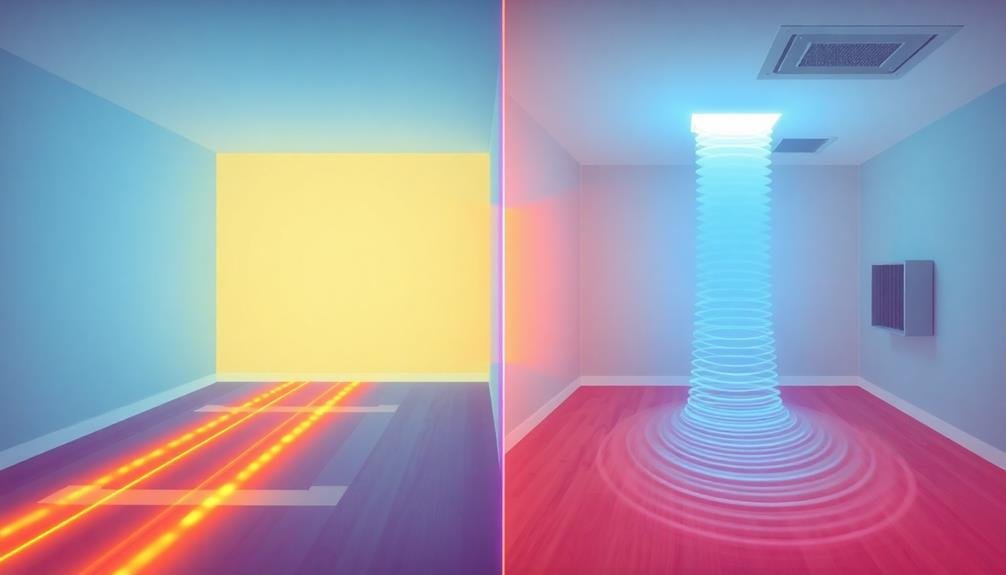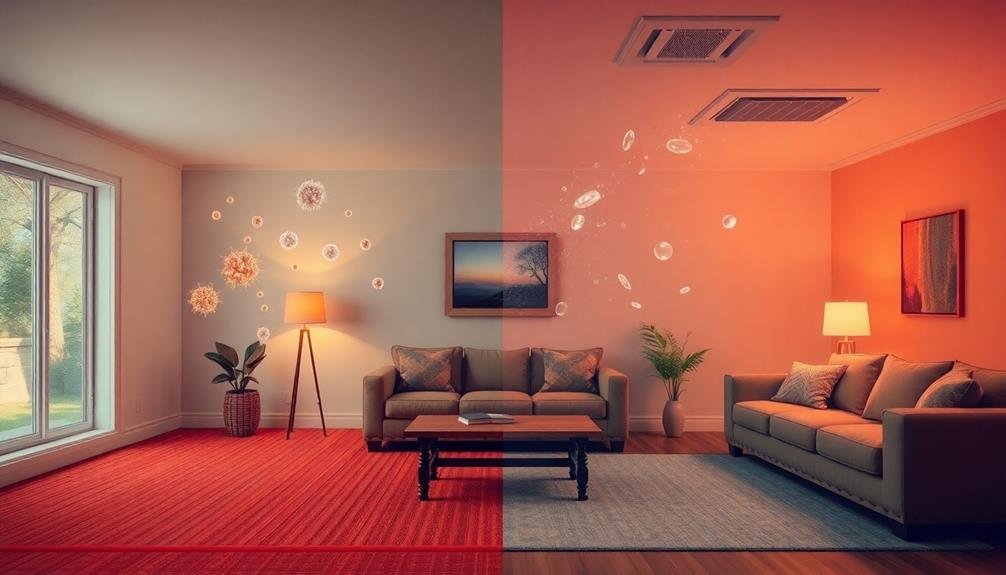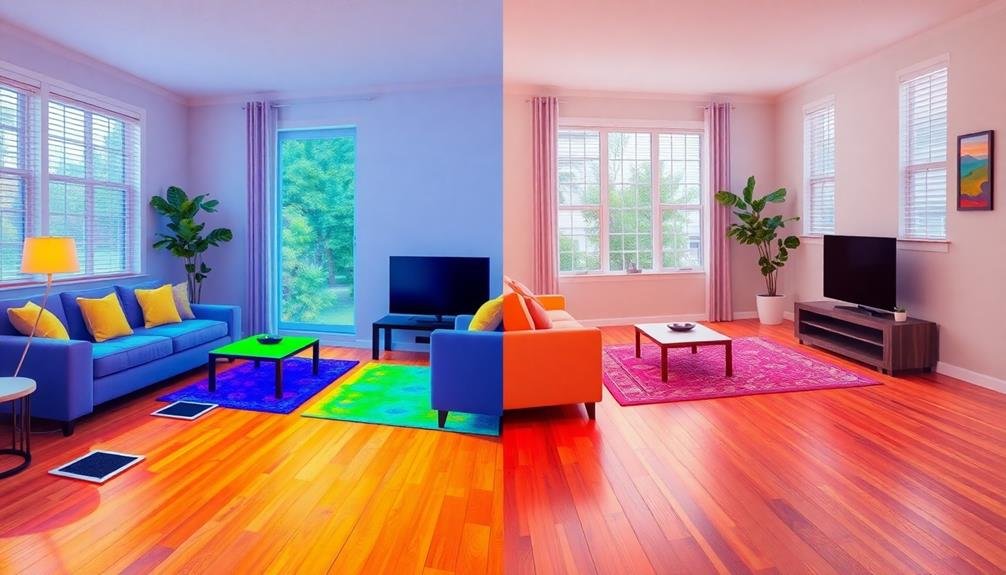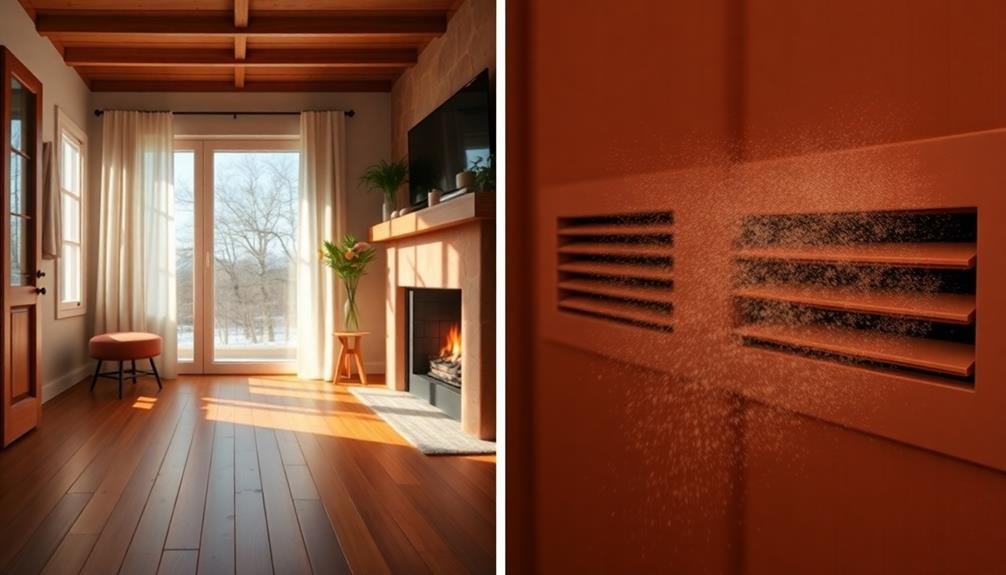When comparing radiant floor heating and forced air systems, you'll find five key differences. First, radiant heating warms objects directly, while forced air circulates heated air. Second, radiant systems are typically more energy-efficient, potentially saving 25-30% on costs. Third, radiant heating improves indoor air quality by not circulating dust and allergens. Fourth, installation complexity differs, with radiant systems being more invasive but requiring less maintenance. Finally, comfort levels vary, as radiant heating provides even warmth without drafts, while forced air can create temperature fluctuations. Understanding these distinctions will help you make an informed decision for your home's heating needs.
Heat Distribution Method

Efficiency lies at the heart of heat distribution methods for radiant floor heating and forced air systems.
With radiant floor heating, you'll experience warmth from the ground up. It works by circulating heated water through pipes beneath your floor, or by using electric heating elements. This method creates an even heat distribution across your entire living space, warming objects and people directly.
On the other hand, forced air systems rely on ductwork to circulate heated air throughout your home. A furnace heats the air, which is then pushed through vents in your floors, walls, or ceilings. While this method can quickly warm a room, it can also create uneven temperature zones and drafts.
Radiant floor heating offers a more consistent temperature throughout your space, as heat radiates upward and doesn't stratify near the ceiling. You'll likely feel comfortable at a lower overall temperature, potentially saving on energy costs.
Forced air systems, while responsive, can create temperature fluctuations as they cycle on and off. They may also circulate dust and allergens, which can be a concern for those with respiratory issues.
Energy Efficiency Comparison
When it comes to your home's energy efficiency, radiant floor heating and forced air systems offer distinct advantages.
Radiant floor heating typically boasts higher energy efficiency. It operates at lower temperatures than forced air systems, reducing heat loss and energy consumption. You'll find that radiant heating distributes warmth evenly, eliminating cold spots and minimizing the need to overheat certain areas. This efficient heat distribution can lead to energy savings of 25-30% compared to forced air systems.
Forced air systems, while less efficient overall, have their merits. They can heat your home quickly, which is beneficial if you need rapid temperature changes. However, they're prone to heat loss through ductwork, especially in unconditioned spaces. You'll need to maintain and seal ducts regularly to maximize efficiency.
Consider your local climate when choosing between the two. Radiant heating excels in colder regions, where consistent warmth is essential. Forced air systems may be more suitable in milder climates or areas with varying heating needs.
Additionally, your home's insulation quality plays a role in each system's efficiency. Well-insulated homes benefit more from radiant heating's steady warmth, while forced air can compensate for insulation deficiencies with its quick heating capability.
Indoor Air Quality Impact

Beyond energy considerations, indoor air quality is a key factor in choosing between radiant floor heating and forced air systems. Radiant floor heating has a distinct advantage in this area. As it doesn't rely on air circulation to distribute heat, it doesn't stir up dust, allergens, or other airborne particles. This can be particularly beneficial if you have allergies or respiratory issues.
Forced air systems, on the other hand, can potentially impact indoor air quality negatively. They circulate air throughout your home, which can spread dust, pollen, and other irritants. However, you can mitigate this issue by regularly changing air filters and maintaining your ductwork. Some forced air systems also offer advanced air filtration options, which can actually improve air quality.
Radiant floor heating doesn't dry out the air like forced air systems can, helping maintain a more comfortable humidity level. This can be especially noticeable in winter months when indoor air tends to be drier.
Additionally, radiant systems don't create the temperature fluctuations or drafts often associated with forced air, contributing to a more consistent and comfortable indoor environment.
Installation and Maintenance Requirements
The installation and maintenance requirements for radiant floor heating and forced air systems differ considerably.
For radiant floor heating, you'll need to install tubing or electric mats under your flooring, which can be a complex and invasive process, especially in existing homes. It often requires removing and replacing flooring, making it more suitable for new construction or major renovations.
Once installed, however, radiant systems require minimal maintenance, mainly annual inspections and occasional bleeding of air from hydronic systems.
Forced air systems, on the other hand, are typically easier to install, particularly in existing homes. They use a network of ducts to distribute heated air, which can be retrofitted into most spaces.
However, they demand more frequent maintenance. You'll need to change air filters regularly, usually every 1-3 months, and have the system professionally cleaned and inspected annually. Ductwork may also require periodic cleaning to remove dust and debris accumulation.
When choosing between these systems, consider your home's structure, your willingness to perform regular maintenance, and your long-term plans for the property.
Each system has its pros and cons regarding installation complexity and ongoing maintenance requirements.
Comfort and Temperature Control

Typically, comfort and temperature control are key factors when choosing a heating system. With radiant floor heating, you'll experience a more even heat distribution throughout your space. The warmth radiates from the floor up, creating a consistent temperature from floor to ceiling. This method eliminates cold spots and drafts, providing a cozy, comfortable environment.
Forced air systems, on the other hand, can create temperature fluctuations. As warm air is blown into the room, it rises quickly, leading to potential hot and cold spots. You might feel warmer near vents and cooler in areas farther away.
Radiant heating offers superior temperature control, allowing you to maintain a steady, comfortable temperature with minimal fluctuation. It's also silent, unlike forced air systems that can be noisy when cycling on and off.
However, forced air systems have the advantage of quicker temperature changes. If you need to warm up a space rapidly, forced air can deliver heat more quickly than radiant systems, which take longer to heat up and cool down.
Both systems can be controlled with programmable thermostats, but radiant heating's consistent warmth may require less frequent adjustments for ideal comfort.
Frequently Asked Questions
How Long Does Radiant Floor Heating Take to Warm up a Room?
You'll find that radiant floor heating typically takes 30 minutes to 2 hours to warm up a room. It's slower than forced air but provides more even, consistent heat. The exact time depends on your system and room size.
Can Radiant Floor Heating Be Installed Under Existing Flooring?
You can install radiant floor heating under existing flooring, but it's challenging. It's easier during new construction or renovation. For existing floors, you'll need to remove them or use specially designed thin systems that go on top.
Are There Specific Flooring Materials That Work Best With Radiant Heating?
You'll find that ceramic tile, stone, and concrete work exceptionally well with radiant heating. They're great heat conductors. Engineered hardwood and luxury vinyl can also be used. Avoid thick carpets, as they'll reduce heat transfer efficiency.
How Does Humidity Control Differ Between Radiant Heating and Forced Air Systems?
You'll find humidity control easier with forced air systems, as they can incorporate humidifiers or dehumidifiers. Radiant heating doesn't directly affect humidity, so you might need separate devices to manage moisture levels in your home.
Can Radiant Floor Heating Be Used for Cooling in Summer Months?
While it's possible, you'll rarely find radiant floor systems used for cooling. They're not as efficient for this purpose. If you want cooling, you'd typically need a separate system or consider a heat pump for both heating and cooling.
In Summary
You've now seen the key differences between radiant floor heating and forced air systems. Consider your priorities: even heat distribution, energy efficiency, air quality, installation ease, and comfort control. Each system has its strengths, so weigh them against your needs and budget. Remember, the right choice depends on your specific situation. Don't hesitate to consult with HVAC professionals for personalized advice before making your decision. Your perfect heating solution awaits!





Leave a Reply